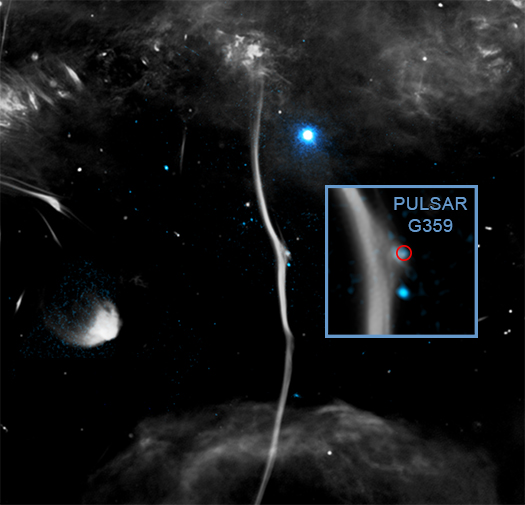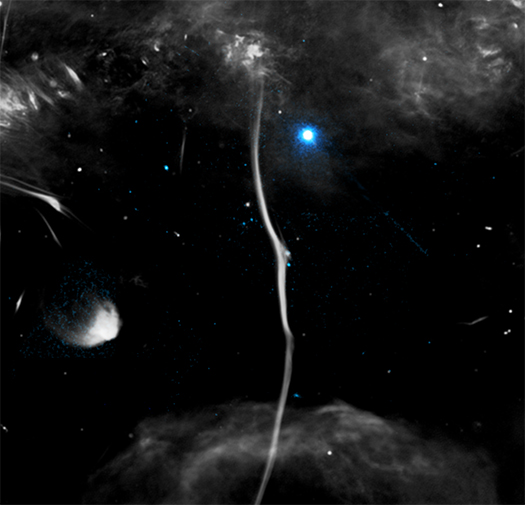NASA's Chandra Diagnoses Cause of Fracture in Galactic "Bone"

G359.13142-0.20005
Credit: X-ray: NASA/CXC/Northwestern Univ./F. Yusef-Zadeh et al; Radio: NRF/SARAO/MeerKat; Image Processing: NASA/CXC/SAO/N. Wolk
Astronomers have discovered a likely explanation for a fracture in a huge cosmic “bone” in the Milky Way galaxy, using NASA’s Chandra X-ray Observatory and radio telescopes.
The bone appears to have been struck by a fast-moving, rapidly spinning neutron star, or pulsar. Neutron stars are the densest known stars and form from the collapse and explosion of massive stars. They often receive a powerful kick from these explosions, sending them away from the explosion’s location at high speeds.
Enormous structures resembling bones or snakes are found near the center of the galaxy. These elongated formations are seen in radio waves and are threaded by magnetic fields running parallel to them. The radio waves are caused by energized particles spiraling along the magnetic fields.

This new image shows one of these cosmic “bones” called G359.13142-0.20005 (G359.13 for short), with X-ray data from Chandra (colored blue) and radio data from the MeerKAT radio array in South Africa (colored gray). Researchers also refer to G359.13 as the Snake.
Examining this image closely reveals the presence of a break, or fracture, in the otherwise continuous length of G359.13 seen in the image. The combined X-ray and radio data provides clues to the cause of this fracture.
Astronomers have now discovered an X-ray and radio source at the location of the fracture, using the data from Chandra and MeerKAT and the National Science Foundation’s Very Large Array. A likely pulsar responsible for these radio and X-ray signals is labeled. A possible extra source of X-rays located near the pulsar may come from electrons and positrons (the anti-matter counterparts to electrons) that have been accelerated to high energies.
The researchers think the pulsar likely caused the fracture by smashing into G359.13 at a speed between one million and two million miles per hour. This collision distorted the magnetic field in the bone, causing the radio signal to also become warped.
At about 230 light-years long, G359.13 is one of the longest and brightest of these structures in the Milky Way. To put this into context, there are more than 800 stars within that distance from Earth. G359.13 is located about 26,000 light-years from Earth, near the center of the Milky Way.
A paper describing these results appeared in the May 2024 issue of the Monthly Notices of the Royal Astronomical Society and is available here. The authors of the study are Farhad Yusuf-Zadeh (Northwestern University), Jun-Hui Zhao (Center for Astrophysics | Harvard & Smithsonian), Rick Arendt (University of Maryland, Baltimore County), Mark Wardle (Macquarie University, Australia), Craig Heinke (University of Alberta), Marc Royster (College of the Sequoias, California), Cornelia Lang (University of Iowa), and Joseph Michail (Northwestern).
NASA's Marshall Space Flight Center in Huntsville, Alabama, manages the Chandra program. The Smithsonian Astrophysical Observatory's Chandra X-ray Center controls science operations from Cambridge, Massachusetts, and flight operations from Burlington, Massachusetts.
